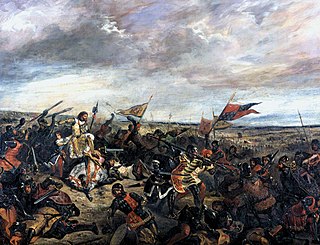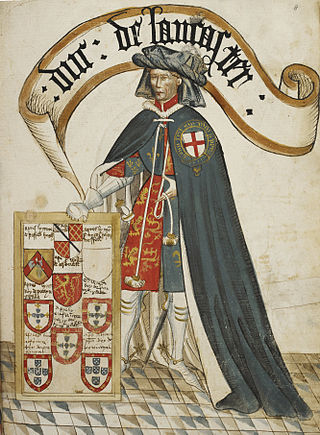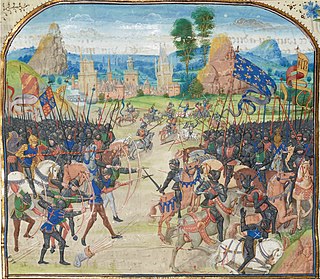
The Battle of Poitiers was fought on 19 September 1356 between a French army commanded by King John II and an Anglo-Gascon force under Edward, the Black Prince, during the Hundred Years' War. It took place in western France, 5 miles (8 km) south of Poitiers, when approximately 14,000 to 16,000 French attacked a strong defensive position held by 6,000 Anglo-Gascons.

The Battle of Neville's Cross took place during the Second War of Scottish Independence on 17 October 1346, half a mile to the west of Durham, England. An invading Scottish army of 12,000 led by King David II was defeated with heavy loss by an English army of approximately 6,000–7,000 men led by Ralph Neville, Lord Neville. The battle was named after an Anglo-Saxon stone cross that stood on the hill where the Scots made their stand. After the victory, Neville paid to have a new cross erected to commemorate the day.

Henry of Grosmont, Duke of Lancaster was an English statesman, diplomat, soldier, and Christian writer. The owner of Bolingbroke Castle in Lincolnshire, Grosmont was a member of the House of Plantagenet, which was ruling over England at that time. He was the wealthiest and most powerful peer of the realm.

The siege of Calais occurred at the conclusion of the Crécy campaign, when an English army under the command of King Edward III of England successfully besieged the French town of Calais during the Edwardian phase of the Hundred Years' War.
A chevauchée was a raiding method of medieval warfare for weakening the enemy, primarily by burning and pillaging enemy territory in order to reduce the productivity of a region, in addition to siege warfare most often as part of wars of conquest but occasionally as a punitive raid. The use of the chevauchée declined at the end of the 14th century as the focus of warfare turned to sieges. It is conceptually similar to the scorched earth strategies used in modern warfare.

The Battle of Caen was an assault conducted on 26 July 1346 by forces from the Kingdom of England, led by King Edward III, on the French-held town of Caen and Normandy as a part of the Hundred Years' War.
The Second War of Scottish Independence broke out in 1332 when Edward Balliol led an English-backed invasion of Scotland. Balliol, the son of a former Scottish king, was attempting to make good his claim to the Scottish throne. He was opposed by Scots loyal to the occupant of the throne, eight-year-old David II. At the Battle of Dupplin Moor Balliol's force defeated a Scottish army ten times their size and Balliol was crowned king. Within three months David's partisans had regrouped and forced Balliol out of Scotland. He appealed to the English king, Edward III, who invaded Scotland in 1333 and besieged the important trading town of Berwick. A large Scottish army attempted to relieve it but was heavily defeated at the Battle of Halidon Hill. Balliol established his authority over most of Scotland, ceded to England the eight counties of south-east Scotland and did homage to Edward for the rest of the country as a fief.
The Truce of Calais was a truce agreed by King Edward III of England and King Philip VI of France on 28 September 1347, which was mediated by emissaries of Pope Clement VI. The Hundred Years' War had broken out in 1337 and in 1346 Edward had landed with an army in northern France. After inflicting a heavy defeat on Philip and a French army at the Battle of Crécy the English besieged Calais, which fell after 11 months. Both countries were financially and militarily exhausted and two cardinals acting for Pope Clement were able to broker a truce in a series of negotiations outside Calais. This was signed on 28 September to run until 7 July 1348.

Lancaster's chevauchée of 1346 was a series of offensives directed by Henry, Earl of Lancaster, in southwestern France during autumn 1346, as a part of the Hundred Years' War.

The Crécy campaign was a series of large-scale raids (chevauchées) conducted by the Kingdom of England throughout northern France in 1346 that devastated the French countryside on a wide front, culminating in the Battle of Crécy. The campaign was part of the Hundred Years' War.

The Black Prince's chevauchée of 1356 was a large-scale mounted raid by an Anglo-Gascon force under the command of Edward, the Black Prince, between 4 August and 2 October 1356 as a part of the Hundred Years' War. The war had broken out in 1337, but a truce and the ravages of the Black Death had restricted the extent of the fighting since 1347. In 1355 the French king, John II, determined to resume full-scale war. That autumn, while Edward III of England threatened northern France, his son, Edward of Woodstock, later known as the Black Prince, carried out a devastating mounted raid, or chevauchée: an Anglo-Gascon army marched from the English possession of Gascony 675 miles (1,086 km) to Narbonne and back. The French refused battle, despite suffering enormous economic damage.
Burnt Candlemas was a failed invasion of Scotland in early 1356 by an English army commanded by King Edward III, and was the last campaign of the Second War of Scottish Independence. Tensions on the Anglo-Scottish border led to a military build-up by both sides in 1355. In September a nine-month truce was agreed, and most of the English forces left for northern France to take part in a campaign of the concurrent Hundred Years' War. A few days after agreeing the truce, the Scots, encouraged and subsidised by the French, broke it, invading and devastating Northumberland. In late December the Scots escaladed and captured the important English-held border town of Berwick-on-Tweed and laid siege to its castle. The English army redeployed from France to Newcastle in northern England.

The Black Prince's chevauchée, also known as the grande chevauchée, was a large-scale mounted raid carried out by an Anglo-Gascon force under the command of Edward, the Black Prince, between 5 October and 2 December, 1355 as a part of the Hundred Years' War. John, Count of Armagnac, who commanded the local French forces, avoided battle, and there was little fighting during the campaign.
Lancaster's chevauchée of 1356 in Normandy was an English offensive directed by Henry, Duke of Lancaster, in northern France during 1356, as a part of the Hundred Years' War. The offensive took the form of a large mounted raid – a chevauchée – and lasted from 22 June to 13 July. During its final week the English were pursued by a much larger French army under King John II that failed to force them to battle.
The sieges of Berwick were the Scottish capture of the town of Berwick-upon-Tweed on 6 November 1355 and their subsequent unsuccessful siege of Berwick Castle, and the English siege and recapture of the town in January 1356. In 1355 the Second War of Scottish Independence had been underway for over 22 years. After a period of quiescence the Scots, encouraged by the French who were fighting the English in the Hundred Years' War, assembled an army on the border. In September a truce was agreed and much of the English army left the border area to join King Edward III's campaign in France.
The siege of Guînes took place from May to July 1352 when a French army under Geoffrey de Charny unsuccessfully attempted to recapture the French castle at Guînes which had been seized by the English the previous January. The siege was part of the Hundred Years' War and took place during the uneasy and ill-kept truce of Calais.
The Treaty of Guînes was a draft settlement to end the Hundred Years' War, negotiated between England and France and signed at Guînes on 6 April 1354. The war had broken out in 1337 and was further aggravated in 1340 when the English king, Edward III, claimed the French throne. The war went badly for France: the French army was heavily defeated at the Battle of Crécy, and the French town of Calais was besieged and captured. With both sides exhausted, a truce was agreed that, despite being only fitfully observed, was repeatedly renewed.
Lancaster's Loire campaign was the march south from Brittany in August 1356 by an English army led by Henry, Duke of Lancaster. He was attempting to join the army of Edward, the Black Prince, near Tours. The French had broken the bridges over the River Loire and Lancaster was forced to turn back, returning to Brittany in September.

The siege of Breteuil was the investment of the Norman town of Breteuil, held by partisans of Charles II, King of Navarre, by French forces. It lasted from April to about 20 August 1356. It was interrupted on 5 July when a small English army commanded by Henry, Earl of Lancaster relieved and resupplied it. The French king, John II, attempted to bring Lancaster to battle with the much larger French royal army, but Lancaster marched away and the attempt failed. John then renewed the siege of Breteuil.

English offensives in 1345–1347, during the Hundred Years' War, resulted in repeated defeats of the French, the loss or devastation of much French territory and the capture by the English of the port of Calais. The war had broken out in 1337 and flared up in 1340 when the king of England, Edward III, laid claim to the French crown and campaigned in northern France. There was then a lull in the major hostilities, although much small-scale fighting continued.







